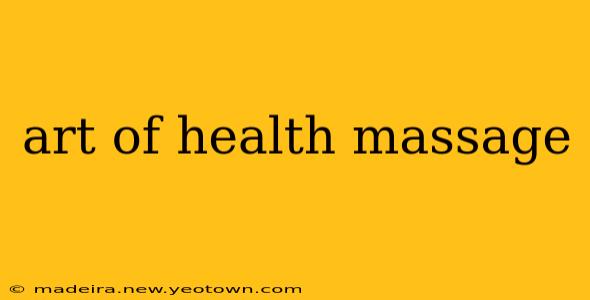The rhythmic kneading, the gentle pressure, the soothing warmth—massage is more than just a luxurious indulgence. It's an ancient art form with a rich history, deeply intertwined with healing and well-being. From the subtle strokes of Swedish massage to the targeted pressure of deep tissue work, the art of health massage encompasses a wide spectrum of techniques designed to address various physical and mental needs. This isn't just about relaxation; it's about unlocking the body's innate ability to heal and thrive.
What are the different types of massage?
The world of massage therapy is surprisingly diverse. Imagine a painter with a palette of colors—a massage therapist has a similar range of techniques to choose from, each with its own unique approach and benefits. Some popular styles include:
-
Swedish Massage: This is often considered the foundational style, using long, flowing strokes to promote relaxation, improve circulation, and reduce muscle tension. Think of it as the gentle watercolor wash on your massage canvas.
-
Deep Tissue Massage: Here, we move into bolder strokes, focusing on deeper layers of muscle and connective tissue. This is ideal for chronic pain, addressing knots and adhesions that may have developed over time. This is like using impasto techniques in painting – thick layers of targeted pressure.
-
Sports Massage: Designed for athletes, this style addresses the specific demands of physical activity, focusing on preventing injuries, improving performance, and aiding in recovery. It's the precise brushstrokes needed to capture the athletic form.
-
Hot Stone Massage: Using smooth, heated stones, this type of massage delivers deep, penetrating heat that helps relax muscles and ease tension. It's like adding warmth and depth to the overall masterpiece.
-
Trigger Point Therapy: This highly focused technique targets specific areas of muscle tension known as trigger points, releasing pain and restoring muscle function. It's the fine detail work that brings the overall picture to life.
Many other styles exist, including aromatherapy massage, prenatal massage, and reflexology, each offering unique benefits and approaches. The best type of massage for you will depend on your individual needs and preferences.
What are the benefits of massage therapy?
The benefits of massage extend far beyond simple relaxation. Studies have shown massage therapy can significantly improve various aspects of health and well-being:
-
Pain Relief: Massage can effectively alleviate pain from various sources, including muscle tension, headaches, and arthritis.
-
Stress Reduction: The relaxing nature of massage can significantly reduce stress hormones, promoting a sense of calm and well-being.
-
Improved Circulation: Increased blood flow delivers more oxygen and nutrients to the tissues, promoting healing and reducing inflammation.
-
Enhanced Flexibility and Range of Motion: Massage helps loosen tight muscles and improve joint mobility, enhancing flexibility and range of motion.
-
Improved Sleep: Regular massage can contribute to improved sleep quality and duration.
How often should I get a massage?
The frequency of massage depends on individual needs and goals. Some people benefit from weekly sessions, while others may find monthly massages sufficient. A consultation with a qualified massage therapist can help determine the ideal frequency for your specific circumstances.
Is massage therapy right for me?
Massage therapy can be beneficial for a wide range of people, but it's essential to consult with a healthcare professional before undergoing massage therapy if you have any underlying health conditions. Your therapist will also conduct a thorough assessment to determine the most suitable type of massage for your individual needs.
What should I expect during a massage session?
A typical massage session involves a consultation to discuss your needs and preferences, followed by the massage itself. After the massage, your therapist may provide recommendations for self-care practices to enhance the benefits of the session. Remember to communicate with your therapist throughout the session—comfort and open communication are key to a successful experience.
The art of health massage is a powerful tool for promoting physical and mental well-being. By understanding the different styles and benefits, you can make an informed choice to embark on a journey towards better health and a more balanced life. Remember, finding the right therapist who understands your needs is just as important as choosing the right type of massage.

